Text
Shinto Gods: Raijin and Fuujin
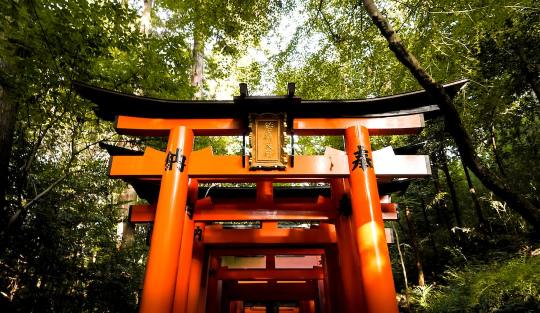
(Photo by Gio Almonte on Unsplash)
Raijin and Fuujin feature in my story The Cry of the Raijuu, but there is so much more to them in real world Shintoism. These are things I learnt about both to influence how I shaped them in my stories.
Raijin
雷神 - らいじん

Raijin’s name comes from a combination of the kanji for thunder (雷 kaminari) and god (神 kami), and he has similar titles all eluding to what he is the god of: storms. When a storm rolls in across the sky, Raijin is there with his drums which he plays with hammers to create thunder. Afterwards, he is often seen mending the damage dealt to them.
The god of storms also goes by the name of Yakusa no ikazuchi no kami (厄災の雷の神) meaning god of storms and disaster as the storms he brings are deadly to those below. Alongside his drumming, he rides dark clouds and throws lightning down, often with his brother Fuujin, the god of winds. He can also be seen fighting with him and causing mischief. Sometimes Raijin brings along the thunder beast Raijuu, and sometimes he can be seen with his son Raitaro too.
Both Raijin and the raijuu have stories about belly buttons, with the raijuu hiding in them and Raijin awakening them with lightning, to Raijin eating children who don’t hide theirs. It is said these stories come from envy at those born naturally, as Raijin is one of a few gods who wasn’t. He was born from the corpse of his mother, Izanami, in Yomi, the land of the dead.
He is a chaotic god shown to be angry and delighted at the destruction he causes and there are stories of how he was unwilling to listen to nearly anyone, including the emperor. He only answers to other deities and revered Buddhist figures. And unlike other deities, Raijin is depicted with a Buddhist halo which is reserved for those holy or divine.
Perhaps it is because they understand the duality of Raijin’s nature. Although he brings storms, Raijin also brings rain which is vital. So much so, it is said that if there is a drought it is because Raijin is at fault, whether that be through laziness or being captured. When his lightning hits crops, it produces a bountiful yield instead of more destruction. He is also shown as a warrior-protector who protects temples and shrines.
While there is much to fear from his presence, he can also be a great boon too, much like his brother Fuujin.
Fuujin
風神 - ふうじん

Fuujin’s name comes from the kanji for wind (風 kaze) and god (神 kami) and that’s exactly what he’s the god of. He also has similar name he goes by, Fuuten (風天) which means heavenly wind. Just like his brother, Fuujin was also born of Izanami in Yomi which is why he is depicted as an oni, just like his brother, and is the most well known oni in Japan. He wears leopard skin, has green skin, and an ogre-like appearance.
Alongside his brother Raijin, Fuujin uses a great bag of air that sits around his shoulders to move himself and the winds around, creating large destructive typhoons down to gentle eddies. Fuujin often rides on a cloud as he does so.
Although most of his winds are seen as destructive, they can be useful too. It is said to be the work of Raijin and Fuujin that caused a storm and later a two day typhoon which stopped the two Mongol invasions in the 1200s.
Of the two gods, he is seen as the lesser one, perhaps because winds are seen as less destructive by themselves.
This is just an overview of the most important details of both gods, but there is more to learn. There are many tales about the Shinto gods and many so fun to read. When I create my version of the gods I try to read as much as I can find to build up a faithful character to the information I’ve found.
6 notes
·
View notes
Text
All about yokai: Onibi

(Photo by Marek Piwnicki on Unsplash)
Onibi are interesting yokai, and ones which are very dangerous. Seen throughout the country in similar forms, they are to be avoided at all costs, if you want to keep your life.
These yokai are different to most I have written about, and yet the moment I learnt of them, I knew I had to write about them. They are one of my favourite yokai, and also similar to will-o’-the-wisps.
Onibi
鬼火 - おにび
Translation: Demon Fire
Onibi are fireballs which are usually blue (compared to a pine torchlight in the Wakan Sansai Zue—an illustrated encyclopedia from the 1700s), however there are also red and yellow onibi, though they are uncommon. Onibi can range in size from a candlelight to around thirty centimetres wide and they often appear in groups of around twenty to thirty floating around one or two meters from the ground.
What makes onibi dangerous is that if a person or animal gets too close, they will drain the energy from their victim. Their lights often lure people closer, imitating lanterns.
Onibi are often to be found in natural areas such as forests and wetlands, but will also show in graveyards and rarely in towns also. They are seen most often in the spring and summer, especially after rain.
It is said onibi are born from dead bodies or uncommonly through intense grudges. There is also a story of sougenbi (叢原火 / 宗源火 "religion source fire") where an onibi was created through Buddhist punishment to a monk who stole. In the onibi his anguished face would float around.
As soon as I learnt about the onibi and how dangerous they could be, a story appeared in my mind of them luring people to their deaths. I enjoy how unlike other yokai which are complex, these only have a few actions, they are created, they want to lure people in, and they want to drain their victims. I built upon these for my story, giving them a little more power. My onibi can manipulate a thick fog to disorientate their victims, so long as the conditions are there to create the fog. I wanted a sinister energy with pure intentions, ones which they wouldn’t stop for because of feelings and emotions, like other yokai.
In my story, One, Two, Three, I wanted to also show them as their own force of nature. That once you get too far, there is no escape. The only way to avoid being killed by onibi is to stay far away. So, when I introduced Iga-san who patrolled the town, there became a deep conflict. With him thinking there could be danger or someone hurt, he had to investigate despite his gut telling him otherwise. Duty overcame instinct.

(Photo by Marek Piwnicki on Unsplash)
Despite being so dangerous, there are instances of onibi appearing and acting in strange ways. There is a story of an onibi that appeared above Hakone mountain which split into two before flying around, combining, and splitting again. And another that appears below the castle and above the sea in Kōchi. Just like the one above Hakone mountain, it flies around splitting and combining, and also appearing very close before flying far away. These onibi can be known as Asobibi (遊火 "play fire").
Similar to the onibi, kitsunebi can be considered a type of onibi. Kitsunebi is also known as fox fire, the fire that comes from kitsune.
There are also similar blue orbs which can be mistaken as onibi called hitodama. They are the visible souls of humans which appear in the same colours of blue, orange, and red. They also float around slowly off the ground, however unlike onibi, hitodama leave behind tails of light. These hitodama are not dangerous at all.
Despite there not being lots of information about onibi, I really enjoyed being able to build upon the folk tales and information noted down by Japanese people. I tried hard to keep them accurate and what I added in line with everything I’d learnt and I definitelt enjoyed writing about them.
If you’d like to read my story about them, they can be found in One, Two, Three.
1 note
·
View note
Text
Free Fantasy Books for December only

I regularly share free or discounted books from BookFunnel, in giveaways and promotions that I join. So here is a link where you can download a number of ebooks all fantasy, all for free. My ebook The Tale of Kami and a Desperate Man is also in this bundle. Please check out the link and maybe you'll find new authors you like!
https://books.bookfunnel.com/fffdecember/vs3ra2b2r1
0 notes
Text
Character Profile: Inari

(Image made on Artbreeder)
Of all of the gods featured in my stories, Inari has to be my favourite. She’s playful, she’s fun, and yet you don’t want to be on her bad side. She also has many kitsune as messengers and spies. And she also seems to have a plan brewing, that will come to light some day. So let’s find out more about her.
Name: Inari
Name with honorifics: Oo-Inari (大稲荷) / Inari Ookami (稲荷大神)
Kanji and kana: 稲荷 - いなり [e-nah-ree]
Deity of: Foxes, fertility, rice, tea, sake, agriculture. She is also patron of blacksmiths and protector of warriors.
Inspirations: Inari was chosen because she is a big god, and at first I only brought her in for a small scene, but I knew I had to write more with her. There was nobody in particular who inspired me while creating her, I created her thinking about her role as a fox goddess and also sake and how she might be a laid back goddess compared to some. I really wanted to keep her marriage with Ukemochi especially as the two are quite different.
First seen in: The Cry of the Raijuu where we see her loving side.
What I like about her:She is a force of her own nature. Inari cares for humans and truly wants to help them, thinking she knows what is best, but of course that’s from the perspective of a goddess. I like how she also gets drunk with people too.
What is fun or hard about writing her: Inari is fun to write and I find her quite easy. She gets trickier to write when she’s being fox-like and a trickster, as I don’t know what she’s planning!
Typical place to find her: In her sanctuary, drinking sake and enjoying company.
MBTI: ESFP-A, The Entertainer
Entertainers know that it’s not all about them – they are observant, and very sensitive to others’ emotions. People with this personality type are often the first to help someone talk out a challenging problem, happily providing emotional support and practical advice. Entertainers usually love a little drama and passion, but not so much when they are the focus of the criticisms it can bring.
If you’d like to know more, ask away and I’ll try my best to answer!
#indie author#writing community#historical fantasy#japan#fantasy#original fiction#original writing#japanese gods#japanese culture#japanese folklore#character profile#original character#character#inari
1 note
·
View note
Text
Lonely Waters

If the shugo-daimyo wouldn’t save his son then I would. He’d be angry and I wasn’t sure what he’d do with me after, but I would not sit by watching this man die.
🌸 🌸 🌸
Kappa are mysterious beings with a wealth of knowledge, and sometimes those in power make the wrong decisions. Standing up for what you believe in isn't always easy, especially when you are an outcast.
Read for free now on AO3, Substack, or another site of your choosing.
Want to support me and read the stories before anyone else? Subscribe via Patreon or Ream. Ream followers (free) also now can read an exclusive story "Tanuki Troubles"!
🌸 🌸 🌸
This story took me on a long adventure. I thought it'd be a happy story with kappa mischief but instead it came out something much deeper. I'm glad I could naturally add a disabled character in too, I've wanted that for a while now.
#indie author#writing community#historical fantasy#japan#fantasy#original fiction#original writing#short story#yokai#writeblr#writers of tumblr#writerscommunity#ao3 writer#kappa#disability#disabled characters#japanese culture#japanese folklore#short fiction
4 notes
·
View notes
Text
How I pick my story locations
Story locations are always a tricky part of story idea forming, especially when you are based in the real world. Japan is a country with many different sceneries from warm beaches to mountains to snow. Many of my stories are located up and down the country but how do I choose where each one will be? Are there places I won’t go at all?
There are two ways I approach a story idea, one is that something in particular inspires me, and I build around it, and the location is a part of that. The other is I find an idea and location can almost be anywhere, so I’m free to mentally wander up and down the country until it feels right. However, I know that none of my stories will be located in the far south islands of Japan, such as Okinawa. I know there is a different dialect this far south, even with different words such as haisai for hello instead of konnichiwa. These words ground characters into their surroundings, and I don’t know enough about them, or the difference in Okinawan culture to do it justice.
The same goes for Hokkaido, which is where the indigenous Ainu people of Japan live. During the 1800s (the end of the timeframe I am writing in) there were many atrocities against these people, including forced assimilation with Japanese people and cultural genocide. This sort of topic would require a lot of research and knowledge I might not be able to find, and feels out of the scope of what I can do. It would be lovely to write about the Ainu people sometime in the future, however, if I’m able to learn enough.
So, when choosing a location, I stay within the bulk of Japan, from Aomori prefecture in the north, to Kagoshima prefecture in the south.
With many of my stories, I have a vague idea of the scenery around. Such as with The Cry of the Raijuu, I placed it in a village in the forest. I knew the city wasn’t too far away and that it was a moderately warm climate. So I looked on Japan’s map and searched for a similar area, and realised that Hirotoshi’s village was somewhere in Nara prefecture.
For One, Two, Three I realised that the town was quite prosperous and I looked into towns which bloomed along the five routes (gokaido), that linked cities together. Many used it to travel, and rested at towns along the way, and many towns grew from the wealth.
The same went for any stories where farming was mentioned, I researched into which prefectures did the most farming, even down to what they farmed, and tried to get it as accurate as possible.
When it came to writing Tanuki Troubles, I could have located it anywhere, as tanuki are known throughout the whole country, however I picked Nigata prefecture as it is where the most tanuki lore is from. I initially wanted to locate them on Sado Island (which is off the coast of Nigata prefecture) where a tanuki shrine can be found, but I found it limiting for my characters exploration. Sado Island is known for the tanuki lore of Danzaburou, a very mischievous tanuki who controlled hundreds of tanuki which ganged up to play with humans. However, Danzaburou was also kind and lent out money to those in need interest-free. With such a huge character already known on the island, I felt like I couldn’t not have him in the story, but he also didn’t fit in mine. So the easiest thing to do was relocate to mainland Nigata instead.
Of all my locations, the one which has surprised me the most is that Broken Waves is set in Kanagawa prefecture. I was looking at all the things I mentioned in my first draft, the sea, the fields, the mountain, and matched it up to farming prefectures. And then I realised Kanagawa fit perfectly. Which would make the mountain in my story Mount Fuji. As soon as I realised this, I loved it so much, as my favourite piece of artwork is Hokusai’s The Great Wave off Kanagawa, and laughed at the possibility in my alternate world that Susnaoo’s wave could have inspired it.
Three of my stories had a more concrete location which I had to build on; Beneath Tsukuyomi, Survival, and Lonely Waters. The former came about while I wrote a short piece about where Hotaka was before the events, and researched into the prefectures where the Takeda clan inhabited. After that, it was easier to figure out where the location was.
For Survival, I was inspired by the Akita and Gifu festival and chose the latter area to locate the story, as it wasn’t too far from where Beneath Tsukuyomi was. For this story, the location didn’t matter as much as trying to keep the festival accurate, as different prefectures have different festivals.
Most recently I wrote Lonely Waters which includes kappa. They are water yokai known for loving rivers and lakes, so for this story I started with the location as my research. I chose Lake Inawashiro which is the fourth largest lake in Japan, and easily home to many kappa without detection, and then built the town around the information I found.
Of the two types, I prefer to find the story then work out where in Japan it is located as I find it fun. I like to compare the feel of my story in my head with ones I have written and what I know, and slowly home in on the rough area where you’d find my characters, living their lives. One day I’ll have a map of all the locations and you can see how well I’ve done.
#indie author#writing community#historical fantasy#japan#original writing#japanese culture#writers of tumblr#writer life#writer things#creative writing#writeblr
0 notes
Text
Historical fantasy and dealing with facts
My series, Tales of Yamato, has been my first real attempt at writing historical fantasy. It wasn’t something I chose, but rather fell into by semi-accident. And because of that, and how I write by discovering as I go, I’ve found how I go about writing this genre is probably different from most.
Long before I started this series, and many years before I even started writing seriously, I, like many writers, wrote fanfic. It was a great way for me to learn writing skills without having to worry about making worlds and characters and I always found it fun. However, deep inside there was always a part of me that had to get the facts right. If my source was a book, I’d need to get everything close to that as I could. Character speech was imitated as best as I could, locations, interactions, everything. It was, and still is, important to me that I got it correct as it wasn’t my world, wasn’t my rules, and I desperately wanted to write the characters true to the author’s vision. Characters who were less fleshed out gave more leeway, but I went over the nuggets of information the author had left and built on that.
This is true now, even with my own writing. If it’s a general fantasy piece then there is much less for me to stick to, however with historical fantasy it’s not. Although, real life is much more difficult to imitate than gathering notes from books. Especially when it comes to writing about Japan, Shintoism, and yokai.
So when I approach a new story, and I rarely know what I am going to write fully before I start writing, it can be quite daunting. I write about the Muromachi period in Japanese history and there are many things which have been documented, but finding that information, finding correct information, and even finding translated information can be difficult. Later periods, such as the Edo period, have much more written about them and sometimes research will lead me to articles which don’t line up with the time I am writing about. I can spend a lot of time going down dead ends or given small paragraphs to work off and it leaves me stumped. It’s still important to me to get this correct, even more so as I’m writing about a culture that isn’t mine, and a place I unfortunately haven’t been to. I want those who do know a lot about my topics to see what I have written and enjoy it and not be put off by things being out of place. I personally have read a story set in London written by an American and I kept losing the immersion because of all the details which were incorrect. And so I don’t want to do that to other people.
That’s where the fantasy comes in.
I’m lucky I can blur the edges on some details as the Japan I write about isn’t the exact Japan of today. They are similar, but I have a leeway to change some things and it not be much of an issue. I still hold myself to the same values as before, and the things that I change I try my hardest to make logical and believable. So as I’m writing and stopping to research every time something new comes up, I’m always finding a happy middle ground between the two.
When it comes to Shintoism, especially the gods, I approach them similarly to how I wrote my fanfic characters all that time ago. I look at all the details given about them, how they present, what tales they have been in, and even what they are a god of as that can give hints at their personality. When I researched into Inari, I noticed how she was god of sake (amongst other things) and so I imagined her being quite laid back and approachable but, as she is also a fox goddess as has kitsune, she is also tricksy and manipulative. Whether for good or bad depends on who you are. She embodies kitsune on a larger level. And so once I had pieced those things together, she was quite easy to write.
Yokai, on the other hand, are a bit of a different matter. The more well known yokai such as kitsune, tanuki, and kappa, have quite a bit of information to go on. They also have ukiyo-e prints which are fun to see and work out how they were viewed by the Japanese people. Others only have a few bits of information to go by. All most likely have more known about them but only written in Japanese, so are out of my reach.
Now I could spend months and months heavily researching every thing I come across, but if I did I wouldn’t have any stories written and might even have become bored by it. So where I can, I lean into the fantasy side and fill in the gaps or make guesses to fully flesh out my world. I try and base yokai actions off of animals behaviour and look at what they are at their core. I take the information I do know and build on it carefully to hopefully let all my readers believe it is all true.
I have no idea how well I done in the whole matter, and once my first draft of Tales of Yamato is done I’ll be getting people who know more about Japan to check through to catch things, but maybe it’ll be enough.
0 notes
Text
A Deceptive Fox
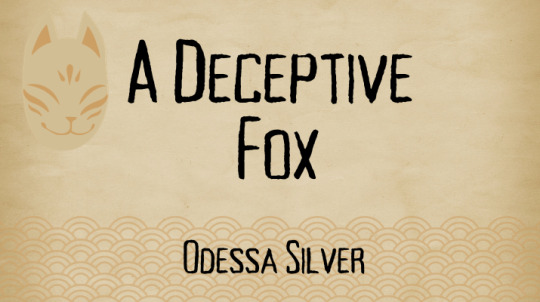
Inari’s eyes darkened. “You’d refuse a god twice?”
I could feel my hands trembling, my heart hammering in the forge of my chest. “Yes.”
🌸 🌸 🌸
Only fools deny Inari once, but how about those who deny her twice?
Read for free now on AO3, Substack, or another site of your choosing.
Want to support me and read the stories before anyone else? Subscribe via Patreon or Ream. Ream followers (free) also now can read an exclusive story "Tanuki Troubles"!
🌸 🌸 🌸
Meeting Hirotoshi again was fun, and I knew his story wasn't over just yet. But again, luck is really not on his side.
#indie author#writing community#fantasy#japan#historical fantasy#original fiction#original writing#short story#yokai#kistune#japanese culture#japanese folklore#inari#shinto#shinto gods#writeblr#writers of tumblr
0 notes
Text
All about yokai: Tanuki

Tanuki are one of the most well known yokai, and these tricksters are fun loving and can even bring good luck. There is so much more to them, however, and just like other shapehifting yokai, can be friendly or deadly. Being a very common yokai, there is a lot of information on them, as well as many legends and folk tales about their antics, and I loved researching them for my story Tanuki Troubles.
They also have a second name, which refers only to their yokai counterpart, the bakedanuki, however the name tanuki can mean both the animal and the yokai version. I stuck with tanuki as it’s the more well known name.
Tanuki/Bakedanuki
狸 - たぬき / 化け狸 - ばけだぬき

Original picture and credit can be found here.
Tanuki are common throughout Japan, living in forests in the in between worlds of human settlements and mountainous areas. Many lived alongside humans too, even with other yokai such as kitsune. And even in some places, tanuki were revered for their many special abilities and they even became a subject of rituals. Because of this, tanuki are held in the highest regard in those specific areas, such as the Sado Islands in Niigata Prefecture, compared to the rest in Japan.
At first, tanuki played a bigger role in Japanese culture, until Buddhism became more popular. This saw the tanuki move to a similar role to kitsune and other magical animals, and they took the roles of being messengers to gods and guardians. Even with this role, they kept their same mischievous streak of tricking people or having fun, or even snatching humans away for the gods. Many don’t fear the tanuki and believe that each one is unique, just like humans.
This is something that I have been trying to convey in my stories too, how some yokai are different because they have their own thoughts and feelings. In Tanuki Troubles I wrote how a father tanuki acts while trying to care for his daughter, and he showed many human-like emotions. Kitsune are also very intelligent and it also makes sense for them to have many thoughts and feelings of their own. I think about each yokai and how they interact with the world, to work out if they would think and feel as we do. There are some that don’t, for example onibi. I see them as feeling only, like a basic instinct for their desires.
There is also a strange phenomenon to do with tanuki, named Tanuki-bayashi (狸囃子) where in the middle of the night out of nowhere comes musical sounds from the forest, like flutes and drums. The sounds onomatopoeia is "pom poko" or "ponpon".
Shapeshifting
The tanuki’s most powerful ability is that of shapeshifting. They love changing into many forms and will place leaves on their head before doing so. And it isn’t just themselves too, they can also transform leaves and pebbles to look like money to trick unsuspecting humans. It’s also how they manage to interact with others humans, by adopting their ways. Some tanuki even adopt human names and integrate by doing jobs or gambling and drinking their money away. There are tanuki who manage to live their whole life without anyone noticing. However, much like humans, they are known to have a bad reputation too with some thieving, lying, and cheating. Others even transform into oni or other scary yokai to terrorise or scare humans for fun.
There are also tanuki who do the opposite and impersonate Buddhist monks, even teaching Buddhism to others. It has been done so often there is a name for it, tanuki-bōzu (狸坊主), where a tanuki is disguised as a round monk, and they lived in burrows beneath temples.
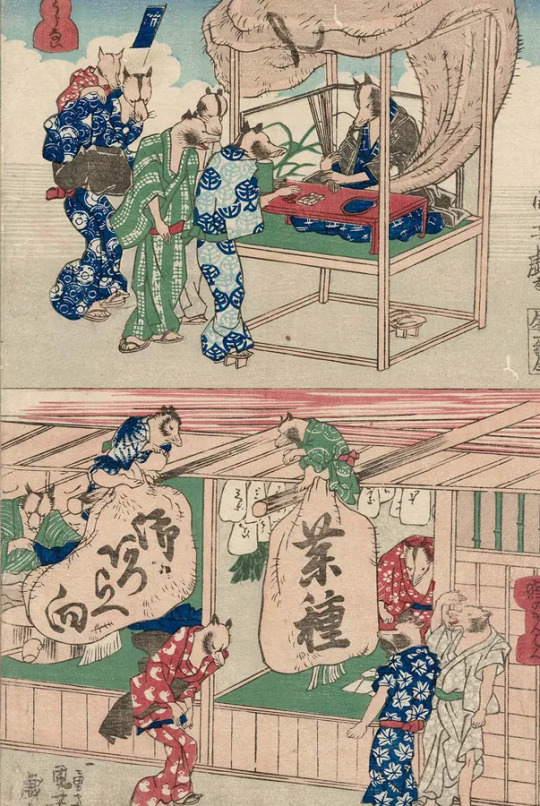
A Tanuki Fortuneteller (Tanuki no uranai 狸のうらない) and Tanuki Shop Signs (Tanuki no kanban 狸のかんばん). From 1843–44 by Utagawa Kuniyoshi.
Tanuki and testicles
A rather surprising ability from the tanuki comes from an unlikely place, their testicles. Tanuki are able to change their body to many forms, and they often use their transforming testicles for many uses, including in their disguises. Testicles can become weapons, drums, fans, umbrellas or nets, and for more elaborate disguises they can be incorporated to become a whole shop or even a boat. Their magical testicles can be adapted for whatever they need.
But where did such a legend come from? Tanuki pelts were used by goldsmiths in the process of hammering gold nuggets into gold leaf. It is said their skin was so good that by wrapping it around the gold it could be hammered out to the size of eight tatami mats. And from there it evolved, and became a symbol of good luck and wealth.
There is even a nursery rhyme about them, learnt by children.
Japanese:
Tan-tan-tanuki no kintama wa,
Kaze mo nai no ni,
Bu-ra bura
English translation:
Tan-tan-tanuki's bollocks,
Even without wind,
They swiiing-swing!

Tanuki Fishing in the River (Tanuki no kawagari 狸の川が) and Tanuki in a Shower (Tanuki no yûdachi狸の夕立).
I found all the legends and folk tales about tanuki fun, even the ones about their testicles, however I couldn’t find a way to include it in my story. Maybe next time!
---
Want to read my story about tanuki? You can read it for free now on Ream by becoming a follower.
#japan#indie author#writing community#fantasy#historical fantasy#original fiction#original writing#short story#japanese folklore#japanese culture#yokai#tanuki#writeblr
7 notes
·
View notes
Text
Character Profile: Hirotoshi

I’ve recently wrote another story about my lovely Hirotoshi, and thought it would be great to share more information about him. It’s been good to see where his journey went after The Cry of the Raijuu and how he kept going after those events.
Name: Hirotoshi Aoi
Kanji and kana: 寛俊 ひろとし - 蒼井 あおい [he-ro-toe-shi—ah-oh-ee]
Meaning: 寛 (hiro) - lenient, gentle, tolerant 俊 (toshi) - excellence
Inspirations: For Hirotoshi’s name, it was actually by luck that I stumbled upon it. I was doing some research into different daimyo and clans and I saw the name Hirotoshi Fukubara. I instantly loved it, and knew I had to use it for my protagonist. His surname was easier, and I chose after one of my favourite Japanese singer/actors Shouta Aoi.
First seen in: The Cry of the Raijuu. Here we meet him at his lowest point, though still filled with so much strength.
What I like about him: Hirotoshi is able to handle a lot, he navigates the tough life he lives and makes it through with so much strength. His faith to Inari is strong and although he relies on her too much, he’s still just a child and doesn’t fully understand the world. His tenacity is probably the most out of every character I have dealt with.
What is fun or hard about writing him: In The Cry of the Raijuu it was hard writing from a child’s perspective. I found a few times he sounded too old, and it was easy to slip into that. However, I love writing how he sees the world, and sees the simple beauty in everything.
Typical place to find him: In the forest. He grew up there, and finds exploring calming and gives him some peace. He goes there whenever he is troubled and needs to think.
MBTI: ISFP-A, The Adventurer
Adventurers live in the present, and they know that they don’t need to dwell on past hurts or frustrations. Rather than focusing on how things could be different, people with this personality type have an incredible capacity for appreciating what’s right about life just as it is.
If you’d like to know more, ask away and I’ll try my best to answer!
#indie author#fantasy#historical fantasy#original fiction#original writing#writing community#original character#character profile#character#writeblr#writers on tumblr
0 notes
Text
Ebooks for everyone!

Everyone likes free books right? Well I have so many to give away from loads of indie authors. There are some which are paid too, as authors need to make a living, but check out the links and you'll find many which are free!
Need something new to try? I have all types of fantasy and sci-fi, plus queer books too. These are all only available this month.
🌸 Fantastic FREE Fantasy: https://books.bookfunnel.com/fantasticfreefantasy/h5s9hr24vz
🌸 Queernorm Worlds Fantasy Fiction: https://books.bookfunnel.com/queernorm_world/e0a97d0ak3
🌸 Free Sci-Fi & Fantasy Books: https://books.bookfunnel.com/abcdef1234/zysjrqnssr
🌸 Science Fiction & Fantasy: https://books.bookfunnel.com/sci-fi-fantasy-free-oct/bwts1nvqm9
🌸 October Free Fantasy books: https://books.bookfunnel.com/octoberbookreview/1g7tdvpzoe
🌸 Free Fantasy & Science Fiction: https://books.bookfunnel.com/octoberfantasy/1elgie28xm
#indie author#writing community#fantasy#original fiction#amreading#free#free books#giveway#queer#queer fiction#queer fantasy#scifi#scifi books#fantasy books#writeblr
34 notes
·
View notes
Text
A Haiku of the Heart

I could tell he knew something was wrong. I heard the light sigh escaping his lips, and his careful steps over the tatami. He only ever tread softly at these times. As he padded over, stepping into my view, I ached to embrace him. But I couldn’t. Not yet.
“What’s wrong, dear wife?”
That stung. I didn’t want him to try and pull me close with sweet words, reminding me I was his. I wanted to stay angry!
🌸 🌸 🌸
Ever wanted to know how Hotaka came to be? Tsukuyomi has been meddling for a while...
Read for free now on AO3, Substack, or another site of your choosing.
Want to support me and read the stories before anyone else? Subscribe via Patreon or Ream. Ream followers (free) also now can read an exclusive story "Tanuki Troubles"!
🌸 🌸 🌸
This story was a strange one to write, but I think it was good seeing the troubles of the every day person and how they try and live their lives. Yokai are everywhere, and it can be surprising when and how they turn up.
#indie author#japan#writblr#writing community#fantasy#historical fantasy#original fiction#original writing#short story#new story#yokai#japanese culture#ghost#ghost child#pregnancy loss
0 notes
Text
Ukemochi and picking a gods' gender
There are many many Shinto gods, moreso than I ever imagined, and every time I do research I learn of even more. The last website I looked into listed 120! And so with a whole list of gods to choose from, and also so many variations between different legends and books, how did I pick?
Beneath Tsukuyomi was easy enough, as when I was planning out the story I needed a connection with the moon, so I just went and did research in the moon god. There wasn’t a lot of information I found to begin with, so I kept him simple. Male god and one who prefers to work and be alone.
Then along came Survival. I wanted to follow on from the threads I put in Beneath Tsukuyomi and build on it. And of course I needed to know where Tsukuyomi was, and if he was ignoring Hotaka or couldn’t answer him. This lead me to bringing in a new god, and with my research I found a wonderful story about Ukemochi preparing a feast, and how it was brought forth disgusted Tsukuyomi so much, he killed them. And I absolutely love legends such as these as I find them fascinating and endearing in a wild way. So I had to use that. Therefore Ukemochi became my antagonist. Now just like Tsukuyomi, there isn’t a lot of information on Ukemochi either, and to make it harder, not everyone agrees on if Ukemochi is a god or goddess.
In Japanese the word for a god/dess is kami and it’s a neutral word. Ukemochi’s full title is 保食神 Ukemochi-no-kami (translation: "Goddess Who Protects Food") but the translation could easily also be god who protects food. To make things harder, Ukemochi goes by another name, although there are theories they aren’t the same person. The second name is Ōgetsu-hime (大宜都比売神/ / Ohogetsu-hime-no-kami), and the hime-no-kami is what makes the distinction here as it means goddess. Ōgetsu-hime is also married to another agriculture god named Hayamato, whereas Ukemochi is told to me married to Inari.
So I had the choice on which to pick, and I decided to go with female presenting, but with gender neutral pronouns (they/them) both to represent what I’d learnt and to add more queer representation. Alongside this, I picked Ukemochi by themselves, not a combination of Ukemochi and Ōgetsu-hime, to try and simplify things. Also, it felt like if I was to ever have them in the same scene, it’d be easier having two different pronouns, as to of the same can get so tricky!
Concerning Inari, Ukemochi in some legends is the wife of Inari, and in others they are Inari. This is one of the problems with mythologies, there is so much overlap and change dependant on so many things such as locations, time, and where it was written. And for my readers I need it to be super clear who is who and to make sure each character is different from the next. Therefore to keep them distinct, I kept away from mentioning Inari in Survival so readers could focus on one new kami.
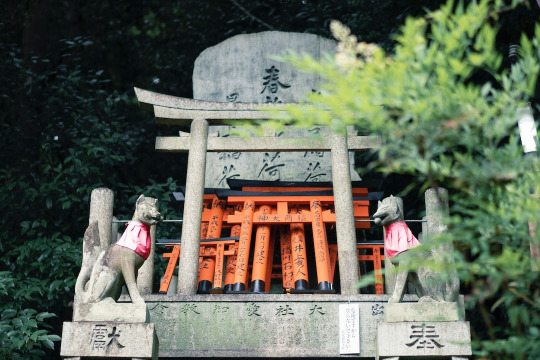
(Photo by JuniperPhoton on Unsplash)
In later stories I brought in Inari, as she was hard to keep away from. The more I read about her, the more I had to include her. For her presentation, I decided to go with part of what she is goddess of and bring that into her personality.
Inari Ōkami (稲荷大神), also called Ō-Inari (大稲荷) or simply Inari, is goddess of foxes, fertility, agriculture (including rice, tea, and sake), industry, and general prosperity. She is also a patron of blacksmiths, swordsmiths, merchants and warriors. Just like Ukemochi, Inari is represented both as female and male. I chose female presenting, and she/her pronouns, as I imagined her in extravagant kimono, her whole look oozing prosperity and good fortune, but not in a negative way. To me, Inari has all this wealth and wants to share it, wants to bless everyone, and is not selfish at all.
Susanoo (Susanoo-no-Mikoto 須佐之男命) is another god who I brought into my stories, known for his violent outbursts and quick temper. I wanted to show his uncertain side, alongside the acts he is known for. He, alongside the other gods Fuujin and Raijin, are always shown as male, so choosing their presentation was easy enough.
When choosing for any god, I look at all the research I can before picking and choosing what works best for both me and my readers. Sometimes it works out well too, such as when I was working out Tsukuyomi’s personality I made him proud and strong. Later on I stumbled over some new information I hadn’t found before and that worked well with what I’d picked, and I also found out he was a brother-husband to Amaterasu too. It’s very common in mythologies for incestuous relationships, however I think it is one I’ll leave behind as at least for my stories, it doesn’t add anything much.
Hopefully, those who know more about the Shinto gods will enjoy the choices I have made, and those who don’t enjoy the gods I have carefully crafted. I’m having so much fun with each of them, and their godly antics.
#japan#japanese gods#japanese culture#japanese folklore#indie author#writing community#fantasy#historical fantasy#inari#writeblr#writers of tumblr#writers on tumblr
1 note
·
View note
Text
All about yokai: The Raijuu
When picking a yokai to feature in my stories, there are a few ways I go about it. For the raijuu it came via a legend, which in turn inspired the story The Cry of the Raijuu. The legend tells of the samurai Tachibana Dōsetsu who was sheltering under a tree during a storm. As lightning struck, he drew his sword to stop it, and once the smoke had cleared all that was left lay a dead raijuu. From then on he renamed his sword, Chidori, Raikiri which means “lightning cutter”.
When I first read this, I loved it so much and wanted to write it badly. I didn’t want to go from the samurai’s perspective though, I wanted another view, of someone seeing such a great feat. And from this I needed to do a lot of research in both Tachibana Dōsetsu and the raijuu.
So how did I pick my raijuu? First I looked into the most basic information I could find about the lightning beast.
Raijū
雷獣 - らいじゅう
Translation: Thunder beast
I chose the spelling raijuu over raiju or raijū for two reasons. Firstly I was unsure how many people would understand the ū sound, as it’s not used in English. In Japanese it’s in place of an uu (and similarly the ō is in place of ou). I could have gone with the simpler raiju, however I’d love if people could pronounce the name as close to the japanese way, so I chose the full version raijuu.
Next I had to pick what type of animal the raijuu was. It is an embodiment of lightning in an animal form, though they have been likened to wolves, dogs, tanuki, and many other animals including even crustaceans. Other sources spoke of a white and blue wolf or dog wrapped in lightning, with a cry sounding like thunder.

The Raijū as depicted in Ban Kōkē's Kanda-Jihitsu.
I also looked in one of my favourite books Yokai by Koichi Yumoto and found this picture too.

From Kaiki Denshōzushi by Motoyama Keisen, as seen in the book Yokai.
Deeper research led me also to popular culture and how they approached the raijuu or raijuu inspired creatures and that made me think of two things from my childhood (and adulthood in case of pokemon!). The pokemon Raikou and the digimon Garurumon.
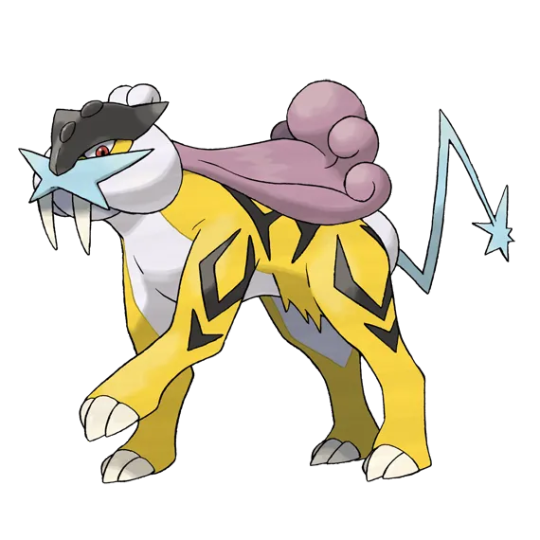
Raikou’s design includes a purple cloud-like mane, and it’s an electric type.
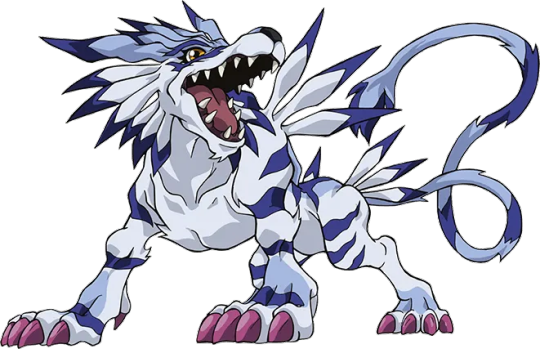
Garurumon is not electric but does have the white and blue wolf shape.
Taking inspiration from it all, I ended up with my raijuu, a white wolf wrapped in blue lightning with black metallic claws which runs along the sky. I decided it can manipulate lightning, run with it, and it is drawn to the metallic nature of the claws. I imagined it’s fur to be coarse and rough, because if it was soft, the static would send mess with the fur. Beneath a coarse layer of fur would be a fluffier layer for warmth, as being high in the sky must be cold. Overall I thought it would be similar to a husky.
For the raijuu’s behaviour, I looked at my research again. It spoke of raijuu leaping around when agitated and striking trees, or creating mayhem wherever they landed. This feared creature comes across as very temperamental and uncontrollable, which fits their master well, Raijin. Raijin, the god of thunder and lightning owns raijuu as pets, and is said to awaken them during thunderstorms.
This leads to a wonderful piece of information I found and desperately wanted to add into my story, but unfortunately I couldn’t do it. Japanese superstition talks of raijuu burrowing into humans’ belly buttons to sleep or hide. And when they are woken up by Raijin, they can hurt the person, so during storms you should sleep on your stomach and/or cover your belly button when you hear thunder.
These feared creatures were quite the mystery to Japanese people, and as they could easily cause much destruction, I made sure to try and convey all that during my story. It was also said that whenever lightning struck, it was believed that a raijuu had been sent by the gods to punish them for some reason.
My poor protagonist ended up with the short straw really, as he wasn’t being punished for anything, he really didn’t do anything wrong. However he battled each challenge well, and Inari was watching with very curious eyes. She isn’t done with him yet.
---
Want to read all about the raijuu? Meet them now in my story The Cry of the Raijuu.
#japan#indie author#writing community#fantasy#historical fantasy#short story#japanese culture#japanese folklore#yokai#raiju#writeblr#writers of tumblr#writers on tumblr
5 notes
·
View notes
Text
That time my protagonist took the reins and suddenly I have a series
Sometimes it’s strange to remember a time when I wasn’t working on Tales of Yamato. It’s been my near-daily life now for a short while, and before that I was planning bits and pieces towards it. But it wasn’t always like this. It wasn’t even meant to be a whole book and more originally.
All the way back when I was writing a short story for Darkness & Moonlight, I had a different idea. It had major Asian influences, magic, and gods, however it ended up more towards the high fantasy genre. After feedback I realised the piece I’d written needed so much more work than I could do in time for the deadline and I had two options. Not have a story for that anthology, or write something new. I wasn’t ready to give up however, and so I went for the latter option.
For those of you who have read my stories, you might agree with a statement that gets given to me often by my beta readers. I’ve whittled it down to: BIG ideas, small space. I seem to have the knack for ideas which could expand out into something much bigger, and yet I cram it into a 2-5k story. Side note: At the very least my currently short stories keep gaining in length and I am learning how to write longer! So because I’d already had a failed story because of plot, and now I had pretty much no time to write a second story, I was worried about the same thing happening again. The thing is, I never do these things on purpose! It just… happens. And gaining ideas itself is tricky for me too, so the whole thing was a crazy idea, but damn I was going to give it a try.
Introducing Hotaka. My saviour and creator of so much chaos, the good kind at least.
During my flailing for an idea, I’d latched on to two things moonlight and the film Saw. Why Saw of all things? Well, I’d reminded myself of something I’d learnt about it on a random facebook post (those are useful after all!); they were low on budget and it made things so much simpler and easier to shoot it all in one room. Bingo. Just what I needed. If I kept my characters to one room, the plot can’t get too out of hand… Right?
So I had a vague location and the moon… and then what? Well amongst this I’d also latched onto a comment of a Japanese saying thanks to the author Natsumi Sōseki: 月が綺麗ですね / tsuki ga kirei desu ne which translates into “The moon is beautiful, isn’t it?”. It’s a beautiful way of saying I love you without saying it directly, and I loved the idea so much. That, and combined with various moon viewing scenes I’d read or watched in the fandoms I am in sealed the deal. (I’ll also talk about the fandom side in a later post!)
Armed with my idea, I broke open a new document and threw myself into the scene. Hotaka immediately emerged, as do most of my characters who make themselves, and oh boy was he looking at Ryoichi. Fantastic. So they did their thing and Hotaka broke my heart, even though I knew what he was going to do, and finally my story was done. I’d written it faster than any other story before (however it also was a shorter than average story unfortunately) and it could be submitted to the anthology after all!
End of story.
No?
Well along comes the next Worldsmyths anthology, this time about seasons. And as I’m trying to figure out what to write again, along with help from some others, Hotaka rears his pretty little head. Summer has wonderful matsuri (Japanese festivals) which are so much fun and another fandom I loved covered it and I fell in love. So here we go again. Hotaka runs around doing his thing some more and it’s a continuation of the first story but still a standalone story, and things are going great and then…
Oh by the way Hotaka is a yokai.
What?
He dropped that little bombshell on me, making me flail and figure out which yokai he might be (I only knew a few back then). And that opened up so many things. I finished the story, ended it in a way that could be continued if I felt like it, or left alone. Part of me knew that Hotaka wasn’t done with me yet.
Fast forward a little more, and while I’m figuring out what I want to do with my author self and also learning all about serialising fiction, Hotaka throws another bombshell at me. I could write more about him and his rich world and serialise it. As with the comment of my BIG ideas always being squished, by doing this I could change that issue by going back and exploring more ideas which had cropped up. I could see other yokai, meet other gods, try to finish writing about Hotaka…
And that’s pretty much where I am now.
Except Hotaka’s story is still not over. I planned one more story with him, making a trilogy of short stories with him in, but it wasn’t enough. Now he has a full prequel too, plus a very small glimpse in between that and where we see him in Beneath Tsukuyomi.
I’ll be sad when I finish the last story with him in. I vaguely know what will happen, and it won’t be long before I write it. However it needs to be done for Tales of Yamato to be complete. He’s resilient and unpredictable, and knowing my luck, he’ll find a way of coming back somehow. But at the same time, I think I’m ready to let him go. He swooped in at my time of need and completely set me on this path, and I’ll be forever thankful for that.
To my Hotaka, who I hope others enjoy as much as I have.
---
The first story I mentioned with Hotaka is Beneath Tsukuyomi, and the second is Survival, both can be read for free right now.
The anthologies they are published in are Darkness & Moonlight and Seasons Unceasing both by Worldsmyths, of which I am a member of.
1 note
·
View note
Text
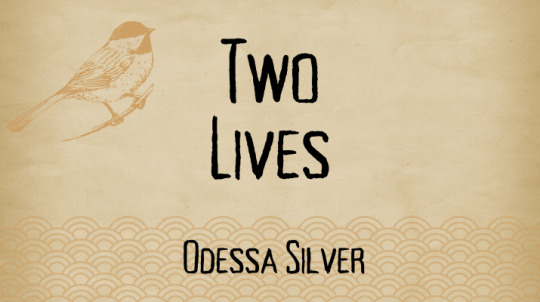
“Here. Take this mere fraction of my power. Use it however you wish, whether that is going to visit Yamato or even making yourself immortal, whatever you desire. A gift to atone for my sister’s punishment.”
“Immortality?” I ruffled my feathers at him. “There is very little up here that can hurt me! Only age will take my life, eventually. You know this.”
“Perhaps, perhaps not.” He let go of me and floated again until his eyes met mine. “There are many gods, and not all of them have your best interests in mind. Nor mine.”
“And what do you get from this?” I said, narrowing my eyes at him. “Such a gift is never given lightly.”
“An alliance. I need protection, and who better to ask than the great sky protectors themselves. I offer you enough power to make many smaller choices, or a big one. That is your choice. Whatever you choose, I ask you help me when I need it, come when I call, and help me in the fight against my enemies. I will do the same for you. Call for me, and I’ll answer if I can.” I stared at him. “Don’t worry,” he added quickly. “I won’t be asking you for anything too big. I hoped suzaku could watch out for threats against me, against humans on Yamato.”
I’d never fought for anything before, how was I supposed to help a god?
🌸 🌸 🌸
Ever wanted to know how Hotaka came to be? Tsukuyomi has been meddling for a while...
Read for free now on AO3, Substack, or another site of your choosing.
Want to support me and read the stories before anyone else? Subscribe via Patreon or Ream. Ream followers (free) also now can read an exclusive story "Tanuki Troubles"!
🌸 🌸 🌸
It was nice to go back to Hotaka and really figure things out. Tsukuyomi has been a thorn in his side for a while but... I like to think it was all good in the end :)
#japan#fantasy#historical fantasy#indie author#writblr#writing community#original fiction#original writing#new story#short story#first person fic#first person pov#yokai#tsukuyomi#japanese culture#japanese gods
2 notes
·
View notes
Text
Japanese Instruments
When writing about a different culture, it’s hard to fully show all the different things in a story without stopping to focus on certain things. One of the things I wish I didn’t have to gloss over so much is the instruments seen in my story Survival. From a storytelling point of view it made sense not to spend much time on them, but I find them interesting.
For the story, I tried to keep it simple and only named a few instruments for the light festival. I named wadaiko, oodaiko, atarigane, and flutes. Later on we also see the koto. But what are they?
Taiko

The larger taiko are nagado daiko, the smaller are shime daiko.
Outside of Japan, we use the term taiko to refer to any Japanese drum, however there are many different drum shapes and sizes, each creating a different sound, and each has a different name.
The most popular and recognised type of taiko is the nagado daiko (also called miya daiko because it’s played in shrines and temples). The larger taiko are nagado daiko, the smaller are shime daiko.
Nagado daiko are made of a wood called keyaki and covered in cowhide. They are also played on stands and hit with sticks called bachi. The drummer can hit the head of the drum or change the sound by hitting the wooden or metal parts.
Similar to the nagado daiko is the Ō-daiko or oodaiko, a much larger drum which produces a deeper sound.
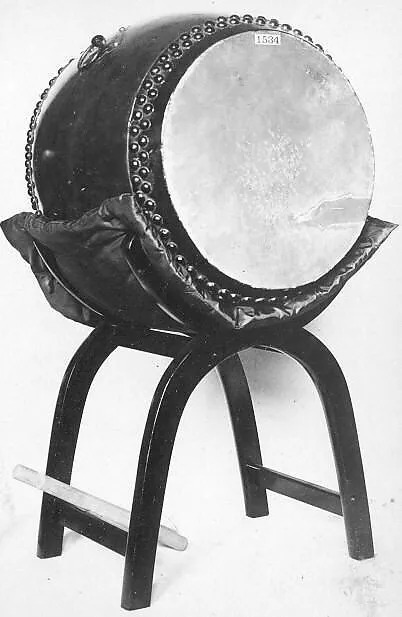
Oodaiko from the 19th Century.
Both of these drums were played at festivals as well as having other purposes throughout history such as for the military, theatre, and religious ceremonies in shrines and temples.
The term wadaiko is a style of drumming on various taiko, full of movement and dynamic group drumming.

Bachi used for drums.
Japanese Flute
To try and keep my terms simple for my story, I omitted the name of the flute and just named it as a flute. However unlike western flutes, the Japanese shakuhachi is made of bamboo and has changed a few times over history. The first version was originally brought over from China and was named the kodai shakuhachi, however it died out around the 10th century. It came back into fashion, however, during the Muromachi period (the one I am writing in) and was named the hitoyogiri shakuhachi. A collective term for all japanese bamboo flutes is fue, in which the shakuhachi is included.
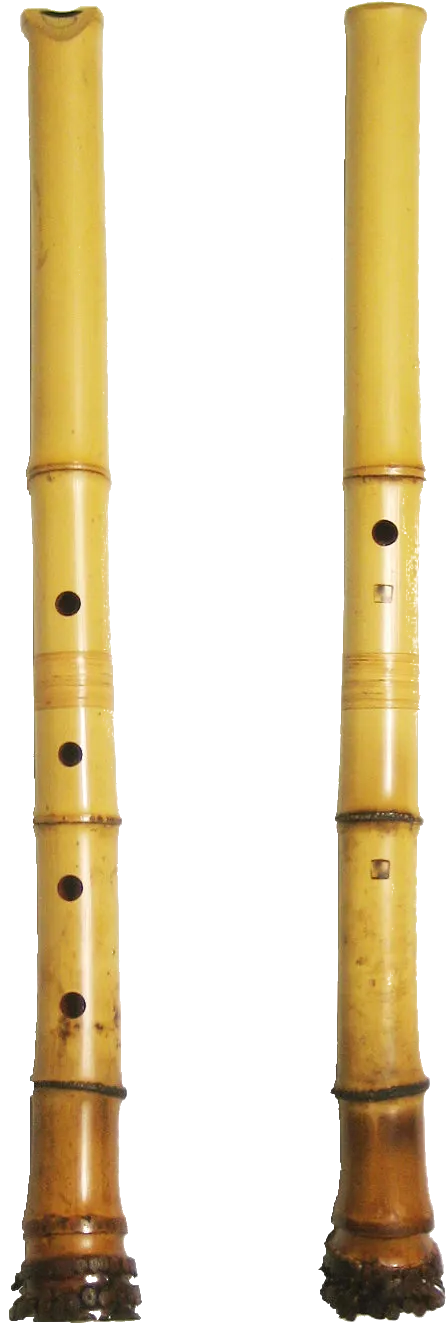
Atarigane
The last named instrument in my festival was the atarigane, a hand held gong which is hit with a mallet called a shumoku or kane yō bachi, made from bamboo and deer antler. They can also be suspended, however are most commonly held. These too are used in shrines and temples, being used in ceremonies and to signify time or certain events.

Koto
The koto is an instrument which is plucked along it’s 13 strings. It’s also now the national instrument of Japan, and very recognisable. It is made of wood, and decorated with ivory, and silk for the strings. Each part of the koto has a name related to dragons, as it is said the koto resembles a dragon itself.
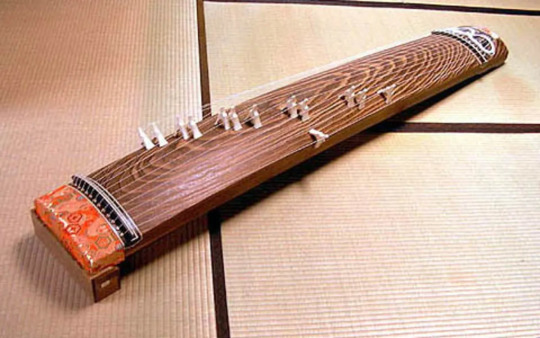
Other instruments
Although those are the only ones which have appeared in my stories so far, there are two other instruments I’d love to bring in if I can.
Shamisen
Another very recognisable instrument is the shamisen, a three stringed instrument plucked with a special plectrum called a bachi. These are different to the ones used by taiko.
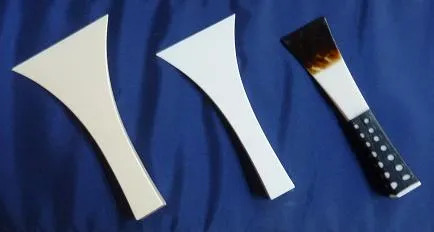
Bachi used for plucked instruments.
It is an instrument similar to a guitar or a banjo, and the body was traditionally covered with animal skin. The shamisen has three strings made from silk, stretched over the head which is made of wood.

"Flowers of Edo: Young Woman's Narrative Chanting to the Samisen" by Kitagawa Utamaro.
Shō
The shō is an instrument made of 17 slender bamboo pipes fitted to a base. Two of the pipes are kept silent on purpose to represent two wings, as the shō is said to sound like the call of a phoenix. It makes an unusual sound and one that maybe is recognisable without realising.
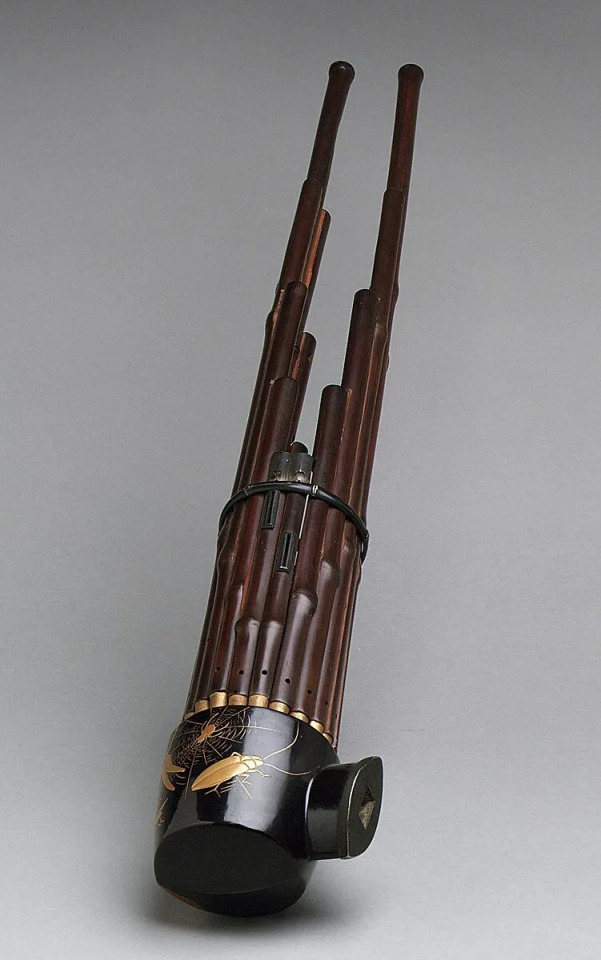
Examples
Taiko: https://www.youtube.com/watch?v=ZagsLrNzg3I
Oodaiko: https://www.youtube.com/watch?v=dj0F-MmPNLk
Shakuhachi: https://www.youtube.com/watch?v=miUKO5g0ONk
Atarigane: https://www.youtube.com/watch?v=7hUqdHCd4vs
Koto: https://www.youtube.com/watch?v=JDTp_YQizqE
Shamisen: https://www.youtube.com/watch?v=RcqO0zkyQRo
Shō: https://www.youtube.com/watch?v=yUpr1F1dZt0
#japan#musical instruments#shamisen#drums#japanese culture#writers on tumblr#writeblr#writers#writing#author
0 notes